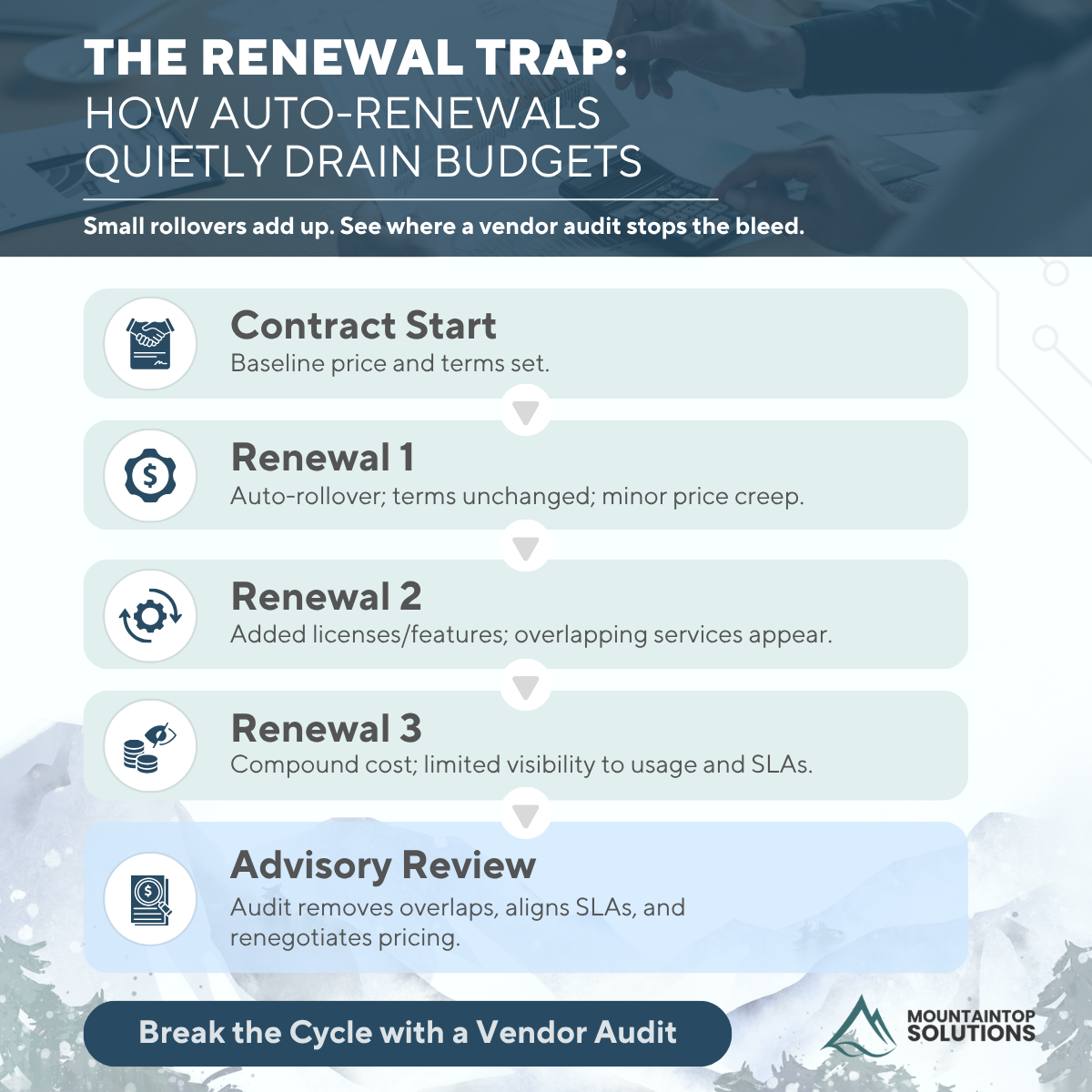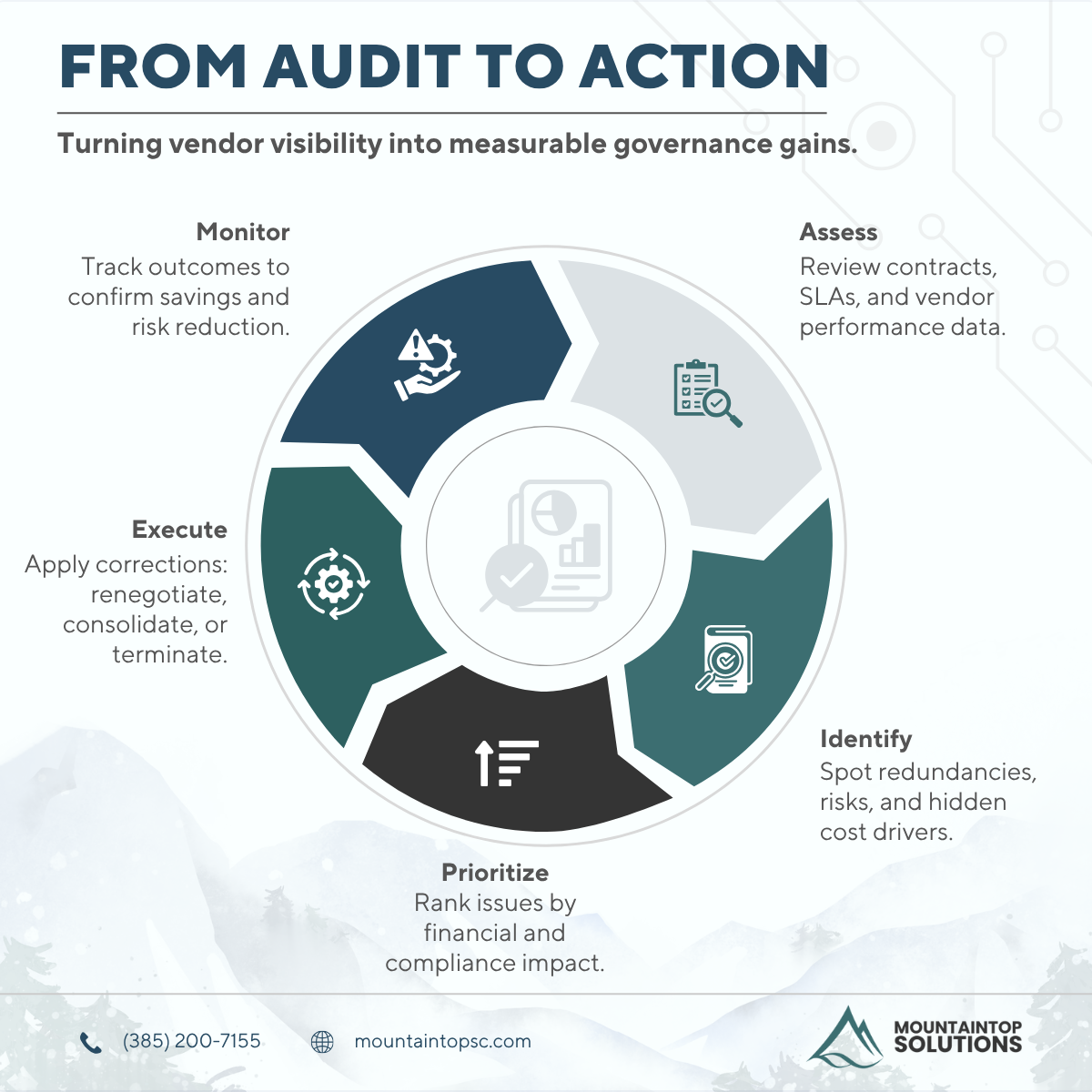Vendor Blind Spots: How Small Gaps Become Big Business Risks
You probably have multiple vendors managing parts of your technology environment, such as connectivity, software, cloud tools, cybersecurity, and more. Each of them promises performance and reliability, but the reality is often more complicated. Small oversights, unclear contracts, and unchecked renewals can quietly drain profit margins without anyone noticing until the budget tightens.
Vendor relationships aren’t just about technology delivery; they’re about accountability and alignment. When vendors operate without structured oversight, costs rise, risks spread, and performance stalls. According to the NAVEX Global 2025 survey, 84 % of organizations agree that their third-party due diligence efforts significantly reduce legal, financial and reputational risks. The issue isn’t always vendor quality; it’s visibility.
Strong oversight begins with clarity. You need to know what you’re paying for, how it’s performing, and who is responsible when something goes wrong. That’s where a structured vendor assessment gives you control. It turns guesswork into measurable performance, linking vendor management directly to financial stability, compliance readiness, and operational resilience.
When you put vendor evaluation and oversight on a regular, disciplined basis you protect margins, support governance and build a vendor ecosystem that aligns with your business goals rather than working against them.
The Quiet Leaks in Vendor Relationships
Most cost leaks in vendor relationships don’t happen overnight. They accumulate through small blind spots, missed renewals, unclear service levels, or unmanaged access permissions.
Unclear SLAs
Service level agreements often look comprehensive on paper but leave critical details undefined. For instance, a cloud provider may guarantee “uptime” without specifying penalties for missed targets or support response times. Without precise terms, your leverage to demand accountability disappears.
Unmanaged Renewals
Auto-renewals are convenient for vendors but expensive for you. Many companies stay locked into outdated contracts long after better pricing or improved technology becomes available. Over time, this complacency turns into a recurring cost burden that eats into your margins.
Third-Party Access Risks
Every external vendor with access to your systems expands your risk perimeter. Unmonitored credentials, inactive accounts, or shared logins can create silent security gaps that threaten compliance. These risks often stay hidden until an audit or incident forces them into view.
Misaligned Objectives
Your vendors are focused on selling and retaining accounts. Your goal is cost efficiency and performance. When these objectives aren’t aligned, you end up overpaying for services that no longer fit your needs.
Fragmented Oversight
Vendor management often lives across departments: finance handles invoices, IT tracks performance, and operations deal with escalations. Without centralized visibility, no one sees the full picture. That fragmentation allows inefficiency to persist unchecked.
The Cost of Complacency
Consider a company using multiple telecom vendors across offices. Each contract was negotiated at different times, with different rates and terms. Over the years, some lines went unused, some contracts auto-renewed at higher rates, and no one revisited the agreements. A simple audit uncovered 28 percent of spend going to services the company no longer needed.
This is how margin erosion happens, not through poor strategy but through silent inattention.
The Power of a Structured Vendor Assessment
A vendor assessment is a structured review of your suppliers, contracts, and service performance. It helps you understand which vendors strengthen your operations and which ones drain resources or expose you to risk.
Most internal reviews focus on cost. But effective vendor evaluation goes further. It examines service quality, risk exposure, contract structure, and business alignment. The goal is to create a system that supports long-term financial and operational control.
Why Internal Reviews Fall Short
Without standardized metrics, internal evaluations often rely on perception. One department may be satisfied with a vendor’s service, while another struggles with response times. This subjectivity hides systemic issues. Without central documentation, data is scattered across emails and spreadsheets. Renewal dates get missed, and the same contract issues repeat year after year.
The Value of External Structure
Vendor evaluation services help you establish consistency. They introduce scorecards that rate vendors on performance, reliability, responsiveness, and cost alignment. Renewal calendars track contract milestones so your team can renegotiate before automatic renewals lock in unfavorable terms. Benchmarking against market standards ensures that your pricing and service levels stay competitive.
Turning Data into Action
Assessment is only valuable when it leads to change. That means turning insights into actions, renegotiating contracts, rebalancing service portfolios, or consolidating vendors. The result is not just cost savings but greater control and predictability across your vendor ecosystem.
When you apply structure to how you assess and engage with vendors, you create a reliable foundation for decision-making. You stop reacting to problems and start managing performance with purpose. Over time, this builds a stronger governance culture where every partnership is measured, optimized, and aligned with your long-term business goals.
How Vendor Assessments Drive Measurable Change
Audits reveal problems. Action solves them. The return on your vendor oversight depends on how effectively you turn findings into improvements. Many organizations stop at identifying inefficiencies, but the real value begins when you translate those insights into measurable outcomes. When you move from audit to action, every decision becomes an opportunity to tighten control, reduce waste, and build resilience across your vendor ecosystem.
1. Contract Clean-Up
A growing software company discovered it had separate telecom contracts for each location, negotiated years apart. By consolidating under one vendor and enforcing updated terms, the business reduced spend by nearly a third and gained centralized billing visibility.
2. Access Control Improvement
During a technology review, it became clear that multiple third-party SaaS vendors retained administrative access long after projects ended. Those inactive accounts posed compliance risks. The solution was to tighten access policies, enforce offboarding protocols, and implement centralized credential management.
3. Renewal Management Discipline
A healthcare organization faced recurring budget spikes because several critical contracts auto-renewed with price escalations. By establishing a renewal review process 90 days before expiration, the company gained time to evaluate options, negotiate rates, or switch vendors when justified.
4. Escalation Framework
When multiple vendors support interdependent systems, accountability can get lost in the shuffle. One organization introduced a formal escalation framework, defining when and how vendors must coordinate during incidents. As a result, issue resolution times improved by 40 percent and internal IT teams reclaimed hours previously spent chasing updates.
5. Vendor Consolidation for Efficiency
A regional logistics company partnered with more than a dozen technology providers, each managing different communication tools. After assessment, the company consolidated under three key vendors and aligned services under a unified contract model. This reduced administrative complexity, lowered monthly costs, and improved service reliability across locations.
6. Performance Benchmarking
A professional services firm used benchmarking data to compare vendor performance against market standards. The results prompted renegotiations with two underperforming providers and performance-based incentives for others. Within six months, the company reported faster response times, better reporting accuracy, and improved budget forecasting.
These examples show the “audit-to-action” principle in motion. Visibility alone doesn’t protect you; consistent execution does. When you take structured action on assessment results, you transform oversight into measurable value. The goal isn’t just to fix what’s broken—it’s to create a vendor environment that continuously improves alongside your business.
Building Governance and Resilience Through Vendor Oversight
Strong vendor oversight strengthens more than your bottom line. It supports compliance, resilience, and operational reliability.
Compliance Readiness
Regulated industries face increasing scrutiny over vendor relationships. Frameworks like SOC 2, HIPAA, or PCI require evidence that third-party providers meet security and performance standards. Consistent oversight ensures that documentation, access controls, and risk evaluations are always current. Instead of scrambling during audits, your records are already aligned with requirements.
Operational Stability
Dependence on external vendors introduces single points of failure. Regular performance reviews verify that vendors can meet their obligations under stress. For example, confirming that a cloud provider has redundancy across regions or that a communications vendor can reroute traffic during outages helps you maintain continuity when incidents occur.
Financial Control
Governance also means financial discipline. Reviewing invoices against contractual terms exposes overbilling, duplicate charges, or unauthorized add-ons. Structured oversight aligns vendor costs with actual business demand. As your operations evolve, so should your vendor mix. Regular reviews ensure that services scale up or down in step with your needs.
Integrating Oversight into Governance
When vendor evaluation becomes part of quarterly or semiannual business reviews, it shifts from a reactionary task to a governance function. Leadership gains real-time visibility into third-party performance and spending. That transparency builds resilience, reduces exposure, and improves planning accuracy.
Governance maturity doesn’t come from adding more tools. It comes from creating a rhythm of accountability.
The Advisor Advantage: Turning Oversight into Strategy
Even with strong intentions, most companies lack the bandwidth to manage dozens of vendors with consistency. That’s where outside guidance adds structure.
A vendor selection consultant or technology advisor brings independent oversight to your vendor ecosystem. Instead of being tied to a specific supplier, an advisor evaluates your environment objectively, identifying overlaps, inefficiencies, and risks that internal teams may miss.
This is not about outsourcing responsibility; it’s about gaining structure and perspective. Advisors help you design evaluation frameworks, negotiate fair terms, and maintain accountability across contracts.
MountainTop Solutions approaches this work like a general contractor for technology. The goal isn’t to sell a particular product but to coordinate the right vendors, enforce standards, and ensure that your technology spend aligns with business outcomes.
With vendor evaluation services, your organization moves beyond reactive management. You gain clear benchmarks for performance, escalation protocols for accountability, and renewal strategies that protect your margins. Over time, this builds what many organizations lack: predictable, transparent vendor relationships that support growth instead of complicating it.
Oversight as an Ongoing Practice
Every vendor relationship carries some level of risk, but those risks multiply when contracts go unchecked. Small issues compound into significant costs. The antidote is structure, evaluating performance, enforcing accountability, and ensuring every vendor supports your goals.
A disciplined approach to vendor oversight doesn’t just prevent problems; it builds confidence. When you have visibility into vendor performance, renewal timelines, and risk posture, your organization gains control over costs, compliance, and resilience.
If your team is ready to bring structure and accountability to vendor management, MountainTop Solutions can help you evaluate your current environment and design a roadmap for better oversight and performance. Book a call with us today.
Summary
What is a vendor assessment and why is it critical for cost and risk management?
A vendor assessment is a structured review of your supplier relationships, contracts, and performance metrics. It helps you identify which vendors deliver value and which create unnecessary cost or risk. By conducting regular assessments, you gain control over spending, improve accountability, and strengthen compliance readiness. This practice turns vendor management into a measurable governance process that protects your margins and keeps your business stable as it grows.







